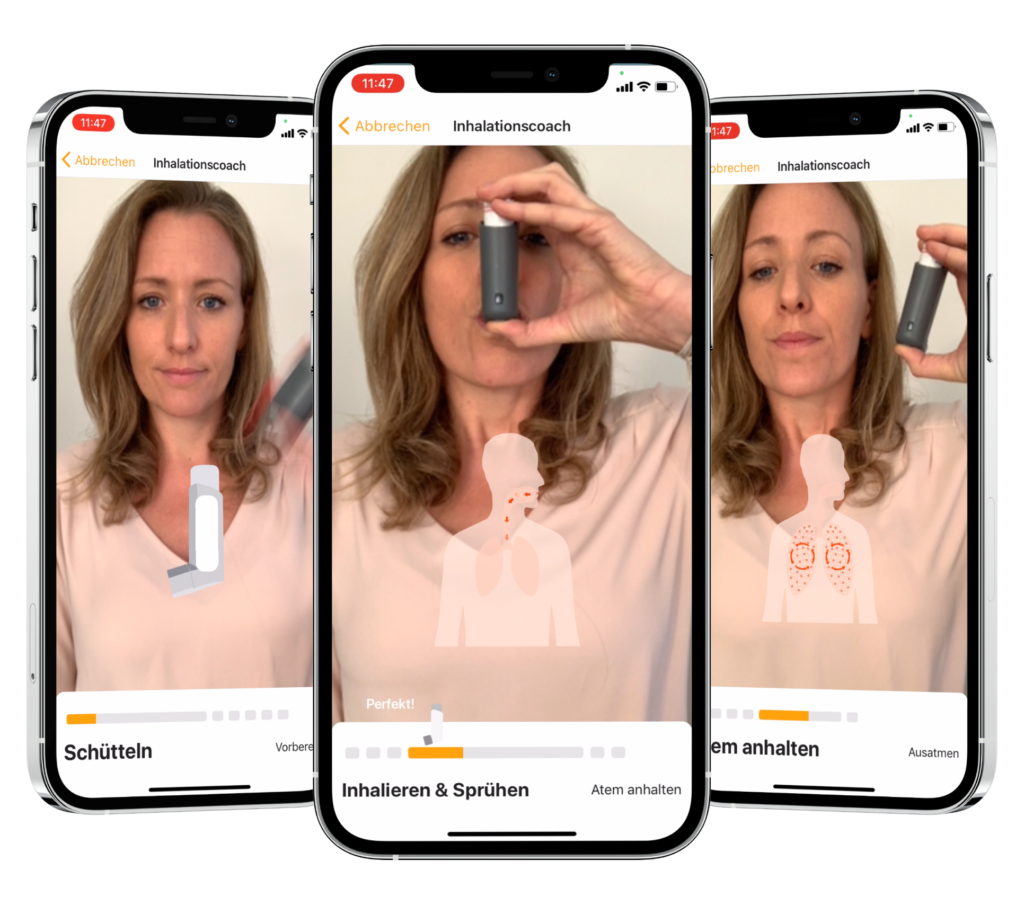
16 Feb How do I inhale correctly?
If you suffer from a chronic lung disease such as asthma or COPD (chronic obstructive pulmonary disease), correct inhalation is essential for a successful therapy. This is often underestimated. Studies show that 55-96% of patients make application errors during inhalation [1], [2]. Of these, 50% are so-called critical errors, meaning that they negatively impact the dose that still reaches the lungs [3], [4], [5]. Poor inhalation technique also correlates with worse disease progression and severe exacerbations [6], [7].
If the medication does not reach the lungs completely, it cannot be effective. For this reason, the treatment success of a pneumological disease depends strongly on the correct handling of the inhalers.
 Another problem is that there are many inhaler models on the market, some of which differ greatly. The most common models of inhalers include metered dose inhalers (MDI) and powder inhalers. The MDI is used by approximately 60% of all inhaled patients [8]. These are sprays in which the active ingredient is stored together with the propellant in a pressurized container. The spray is triggered by pressing down on this container [9].
Another problem is that there are many inhaler models on the market, some of which differ greatly. The most common models of inhalers include metered dose inhalers (MDI) and powder inhalers. The MDI is used by approximately 60% of all inhaled patients [8]. These are sprays in which the active ingredient is stored together with the propellant in a pressurized container. The spray is triggered by pressing down on this container [9].
The inhalation trainer Kata® supports you in your inhalation process by describing the individual steps of the inhalation process in a simple way. To do this, it uses the signals from your smartphone’s camera and microphone and analyzes and evaluates the individual steps of the inhalation maneuver by combining augmented reality and artificial intelligence. After an inhalation maneuver, you receive detailed feedback in text and image, which includes an individual evaluation of each inhalation step and, if necessary, recommendations for action for the upcoming inhalations. At the end of the procedure, Kata® shows you which of the steps you have performed correctly.

Inhalation with the metered dose inhaler
When inhaling, you should ensure that your body is in an upright position. If you use a metered dose inhaler (MDI), you should shake it well in the first step. Shaking a MDI before use is particularly important with suspension sprays to avoid incorrect dosing due to sedimentation of the active ingredient particles. Then prepare for inhalation. To ensure that the medication can reach your lungs well, exhale forcefully but slowly before inhalation. Make sure that you do not exhale into the inhaler. The next step is to perform the inhalation. In doing so, enclose the mouthpiece with your lips and trigger the device at the beginning of the inhalation phase. Take your time during this step and make sure that you inhale slowly and deeply. This is followed by a breathing pause. This can last about 5-10 seconds and is necessary so that the medication can be distributed in the lungs. Finally, you can exhale vigorously again.
Kata® shows you exactly how and for how long you should perform these steps, helps you to achieve a more effective therapy and offers support not only for the MDI but also for other commonly used inhalers. If you would also like to see a video on correct inhalation with the metered dose inhaler, we recommend the website of the Deutsche Atemwegsliga e.V.. On the website you will also find more inhalation videos with other inhaler types.
Sources:
[1] J.A.M. Westerik, V. Carter, H. Chrystyn, A. Burden, S.L. Thompson, D. Ryan, K. Gruffydd-Jones, J. Haughney, N. Roche, F. Lavorini, A. Papi, A. Infantino, M. Roman-Rodriguez, S. Bosnic-Anticevich, K. Lisspers, B. Ställberg, S.H. Henrichsen, T. van der Molen, C. Hutton, D.B. Price, Characteristics of patients making serious inhaler errors with a dry powder inhaler and association with asthma-related events in a primary care setting, Journal of Asthma. 53 (2016) 321–329. https://doi.org/10.3109/02770903.2015.1099160.
[2] W. Windisch, S.B. Schwarz, F.S. Magnet, M. Dreher, C. Schmoor, J.H. Storre, V. Knipel, Using web-based videos to improve inhalation technique in COPD patients requiring hospitalization: A randomized controlled trial, PLoS ONE. 13 (2018) e0201188. https://doi.org/10.1371/journal.pone.0201188.
[3] Lavorini, F., Magnan, A., Dubus, J. C., Voshaar, T., Corbetta, L., Broeders, M., … & Crompton, G. K. (2008). Effect of incorrect use of dry powder inhalers on management of patients with asthma and COPD. Respiratory medicine, 102(4), 593-604.
[4] Melani, A. S., Bonavia, M., Cilenti, V., Cinti, C., Lodi, M., Martucci, P., … & Neri, M. (2011). Inhaler mishandling remains common in real life and is associated with reduced disease control. Respiratory medicine, 105(6), 930-938.
[5] Price, D., Bosnic-Anticevich, S., Briggs, A., Chrystyn, H., Rand, C., Scheuch, G., … & Inhaler Error Steering Committee. (2013). Inhaler competence in asthma: common errors, barriers to use and recommended solutions. Respiratory medicine, 107(1), 37-46.
[6] Price et. al. Inhaler errors in the CRITIKAL study
[7] Molimard, M., Raherison, C., Lignot, S., Balestra, A., Lamarque, S., Chartier, A., … & Girodet, P. O. (2017). Chronic obstructive pulmonary disease exacerbation and inhaler device handling: real-life assessment of 2935 patients. European Respiratory Journal, 49(2).
[8] Haidl, P., & Köhler, D. (1999). Geographische und ökonomische Aspekte der Inhalationstherapie. Pneumologie, 53(12), 612-616.
[9] Deutsche Atemwegsliga e.V. (2022). Pulverinhalatoren. Zugriff am 01.09.2022. Verfügbar unter https://www.atemwegsliga.de/pulverinhalatoren.html
Author: Anna Vögtle
